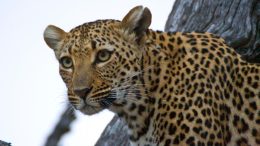I started writing about conservation 20 years ago because I kept seeing so many interesting scientific papers that never seemed to make a splash beyond their initial publication.
Little has changed. In just the past month, I’ve seen dozens of new papers that I thought deserved exposure but didn’t appear to reach a wide audience.
That’s why I launched “This Month in Conservation Science” — to get people talking.
Here are more than two dozen papers that have grabbed my attention in the past few weeks. They cover picky otters, shrimp that live in trees, roaming leopards, changed landscapes, overheated turtles, youth reactions to climate change, and more. Most of the articles are open access, so they should be available to researchers (and any other interested readers) around the globe.
-
- “A new species of nightjar (Caprimulgus) from Timor and Wetar, Lesser Sunda Islands, Wallacea” (Ibis)
- “Climate futures for lizards and snakes in western North America may result in new species management issues” (Ecology and Evolution)
- “The Earth is dying, bro” (M/C Journal)
- “Emaciated enigma: Decline in body conditions of common dolphins in the Celtic Seas ecoregion” (Ecology and Evolution)
- “Fair division for avoidance of biodiversity impacts” (Trends in Ecology & Evolution)
- “First peoples’ names for Australian birds? Only with free, prior and informed consent” (Emu – Austral Ornithology)
- “Global primary predictors of extinction risk in primates” (Proceedings of the Royal Society B: Biological Sciences)
- “Hidden gems: Scattered knowledge hampered freshwater jellyfish research over the past one‐and‐a‐half centuries” (Ecology and Evolution)
- “Investigating the distribution of a unique crustacean microendemic to tree hollows” (The Science of Nature)
- “Local extirpation of woody species in Colophospermum mopane woodland under chronic utilisation by elephants” (African Journal of Ecology)
- “Microplastics and chemical contamination in aquaculture ecosystems: The role of climate change and implications for food safety — a review” (Environmental Sciences Europe)
- “Natural shading is helpful but not sufficient for mitigating warming in green sea turtle nests in the tropical South China Sea” (Biological Conservation)
- “Rediscovery and future approaches to conservation of the elusive giant salmon carp Aaptosyax grypus, a Critically Endangered megafish in the Mekong” (Biological Conservation)
- “Seed dispersal by bats (Chiroptera: Phyllostomidae) and mutualistic networks in a landscape dominated by cocoa in the Brazilian Amazon” (Global Ecology and Conservation)
- “Small forest patches in West Africa: mapping how they are changing to better inform their conservation” (Environmental Conservation)
- “Taxonomic revision of the king cobra Ophiophagus hannah species complex, with the description of two new species” (European Journal of Taxonomy)
- “Tracing seven decades of Chinese wildlife legislation from 1950 to the COVID-19 pandemic era” (Biological Conservation)
- “Why do Eurasian otters eat so few invasive blue crabs?” (European Journal of Wildlife Research)
Spot(light) on leopards:
This month saw several interesting papers about these threatened felines (and other nearby species, including humans):
-
- “Leopards on the edge: Assessing population status, habitat use, and threats in Southeast Asia” (Biological Conservation)
- “Identifying priority areas for the Indian leopard (Panthera pardus fusca) within a shared landscape” (Ecology and Evolution)
- “Are wild prey sufficient for the top predators in the lowland protected areas of Nepal?” (Ecology and Evolution)
- “Distribution patterns of tigers and leopards in Thung Yai Naresuan (East) Wildlife Sanctuary, Western Thailand” (Ecology and Diversity)
- “Human activities reshape the spatial overlap between North Chinese leopard and its wild ungulate prey” (Frontiers in Zoology)
- “Droughts reshape apex predator space use and intraguild overlap” (Journal of Animal Ecology)
- “Human-wildlife conflict in Bardia-Banke Complex: Patterns of human fatalities and injuries caused by large mammals” (Ecology and Evolution)
- “Cub survival in a wild leopard (Panthera pardus fusca) population” (Animals)
In-depth:
Beyond those individual papers, the journal Rangeland Ecology & Management has published an entire open-access issue on sagebrush conservation that covers a wide range of interesting subjects.
We found these papers through a combination of email alerts, RSS feeds, newsletters, notes from researchers, and other sources. We’re happy to hear from any author or team who has a new paper coming out in a peer-reviewed journal or other publication, especially if you’re from the Global South or an institution without much public-relations support. For consideration in a future column, drop us a line at [email protected] and use the subject line TMICS. (Our next column will focus on material published between Oct. 20 and Nov. 20, 2024.)

Previously in The Revelator:
This Month in Conservation Science: The Eagles Who Ate the Lions


